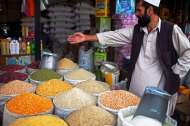Human Wrongs Watch
Under the slogan ‘nutritious seeds for a sustainable future,’ the United Nations, led by its Food and Agriculture Organization (FAO), on 10 November 2015 launched the 2016 International Year of Pulses to raise awareness about the protein power and health benefits of all kinds of dried beans and peas, boost their production and trade, and encourage new and smarter uses throughout the food chain.
“Pulses are important food crops for the food security of large proportions of populations, particularly in Latin America, Africa and Asia, where pulses are part of traditional diets and often grown by small farmers,” said FAO Director-General José Graziano da Silva, in a news release.
“They have been an essential part of the human diet for centuries,” he added, “Yet, their nutritional value is not generally recognized and is frequently under-appreciated.”
According to FAO, pulses, including all kinds of dried beans and peas, are not merely cheap and delicious; they are also highly nutritious source of protein and vital micronutrients that can greatly benefit people’s health and livelihoods, particularly in developing countries.
There are hundreds of varieties of pulses grown throughout the world. Popular ones include all varieties of dried beans, such as kidney beans, lima beans, butter beans and broad beans. But also chickpeas, cowpeas, black-eyed peas and pigeon peas.
Speaking about their nutritional value, the FAO chief said that pulses have double the proteins found in wheat and triple the amount found in rice. They are also rich in micronutrients, amino acids and b-vitamins; Mr. Graziani da Silva underlined, and added that they are vital parts of a healthy diet.
Further, the agency credited pulses as the key ingredients in many signature regional and national dishes across the world – from falafel to dahl to chilli and baked beans.
FAO also added that as an affordable alternative to more expensive animal-based protein, pulses are ideal for improving diets in poorer parts of the world, where protein sources from milk if often five time more expensive than protein sourced from pulses.
Pulses also offer a great potential to lift farmers out of rural poverty, as they can yield two to three time higher prices than cereals, and their processing provides additional economic opportunities, especially for women.
Following his address, Mr. Graziano da Silva planted a number of fava beans in a planter full of soil as he proclaimed the International Year opened.
“The International Year 2016 is a great opportunity to raise awareness of the benefits of pulses as the world embarks on efforts to achieve the newly adopted Sustainable Development Goals,” said UN Secretary-General Ban Ki-moon in a message on the occasion.
Ban added that pluses contribute significantly in addressing hunger, food security, malnutrition, environmental challenges and human health and also are a vital source of plant-based proteins and amino acids.
“Despite strong evidence of the health and nutritional benefits of pulses, their consumption of pulses remains low in many developing and developed countries. The International Year can help overcome this lack of knowledge,” said Ban.
Further, he also said that pulses impact the environment positively due to their nitrogen-fixing properties, which increase soil fertility.
“Much work needs to be done to end hunger and provide food security and nutrition for all. One concrete, promising opportunity lies with pulses. Let us join forces to raise awareness of the benefits of pulses,” said the Secretary-General.
The UN chief also called for collaborative commitment and concrete action by all relevant actors within the UN system, farmers’ organizations, civil society and the private sector, to make the International Year of Pulses 2016 a success.

Because pulses yield two to three times higher prices than cereals, they also offer great potential to lift farmers out of rural poverty. | FAO
Untapped potential
Pulses are part of the food culture and standard diet in most parts in the world and a key ingredient in many signature national and regional dishes, from falafel to dahl to chilli and baked beans, says FAO.
There are hundreds of varieties of pulses grown throughout the world. Popular ones include all varieties of dried beans, such as kidney beans, lima beans, butter beans and broad beans. But also chickpeas, cowpeas, black-eyed peas and pigeon peas (learn more: What are pulses), it adds.
They are an affordable alternative to more expensive animal-based protein, which makes them ideal for improving diets in poorer parts of the world. Protein sourced from milk, for example, is five times more expensive than protein that can be sourced from pulses.
Because pulses yield two to three times higher prices than cereals, they also offer great potential to lift farmers out of rural poverty, and processing provides additional economic opportunities, especially for women.
Health benefits
While small, pulses are packed with proteins – double that found in wheat and three times that of rice.
They are also rich in micronutrients, amino acids and b-vitamins, which, the FAO Director-General underlined, are vital parts of a healthy diet.
Low in fat and rich in nutrients and soluble fibre, pulses are also excellent for managing cholesterol and digestive health, and their high iron and zinc content makes them a potent food for combating anemia in women and children.
They are a key ingredient in healthy diets to address obesity and to prevent and manage chronic diseases such as diabetes, coronary conditions and cancer.
Because of their high nutritional content, pulses are a staple in emergency food baskets and since they do not contain gluten, they are also suitable for celiac patients.
Benefits for animals and the environment
But pulses don’t just benefit human health – they also improve animal and soil health and support biodiversity.
Crop residues from pulses can be used as animal fodder to increase nitrogen concentration in the diet, which improves animal health and growth.
The FAO Director-General particularly highlighted how the nitrogen-fixing properties of pulses can improve soil fertility, which extends the productivity of farmland, and eliminates dependency on synthetic fertilizers. The latter leads to a smaller carbon footprint and indirectly reduces greenhouse gas emissions.
What’s more, by improving soil health overall, pulses promote below-the-surface biodiversity, too, as they create a rich home for germs, bugs and bacteria of various kinds.
Because pulses as a group are very genetically diverse, they also hold a great potential for climate adaptation, as they enable farmers to select new varieties to adjust their production to changing climate conditions.
Finally, using pulses as cover crops and in intercropping systems – planting them in between other crops or as part of crop rotations — can reduce soil erosion and help control pests and diseases.
The co-chairs of the steering committee of the International Year of Pulses, Aydin Adnan Sezgin and Nadeem Riyaz, Permanent Representatives of Turkey and Pakistan to FAO, made opening and closing remarks at today’s [10 November 2015] ceremony, which also included a presentation by Mahmoud Solh, Director-General of the International Center for Agricultural Research in the Dry Areas (ICARDA).
Other recent international years have focused on soils, family farming, and quinoa.
(Source: UN).



Leave a comment